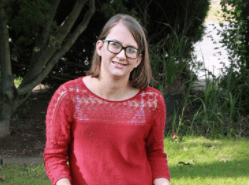The Challenge: Seizures
Sara Myers is a 24-year-old native of Ligonier, Pa. She loves playing with her dog, going out to eat, shopping, and spending time with her niece and nephews.
She’s also struggled with seizures since she was a child.
Corinne Myers, Sara’s mom, explains her daughter was born with a genetic abnormality: a duplicated 15th chromosome. People with this disorder also often have autism, scoliosis, growth delays, and epilepsy.
From an early age, Sara has lived with many of these conditions including autism and epilepsy.
Though born with this extra copy of chromosome 15, it wasn’t until Sara turned 14 that she and her family learned about it. That’s when Sara had her first grand mal seizure and went to UPMC Children’s Hospital of Pittsburgh for treatment.
“We went to our local hospital first,” Corinne says. “They thought Sara had suffered a syncope. But Sara’s sister, a nurse, recognized it as a grand mal seizure and urged us to go to Pittsburgh.”
The Solution: Vagus Nerve Stimulation
At UPMC Children’s Epilepsy Monitoring Unit, neurologists treated Sara and diagnosed her with chromosome 15q duplication.
From that point forward, Sara began seeing a UPMC neurologist to keep an eye on her seizure activity.
As part of her treatment, Sara received a vagus verve stimulator (VNS) implant.
The vagus nerve is in the neck. It carries messages to and from the brain, which makes it a key target for treating epileptic seizures.
Doctors implant the VNS under the skin near the collarbone, where a wire connects the device to the vagus nerve.
Neurologists then program the VNS to produce weak electrical signals that travel along the vagus nerve to the brain at regular intervals. These signals help prevent the electrical bursts in the brain that cause seizures.
Since the VNS uses a battery, Sara can turn it on if she feels a seizure about to start.
She also wears a magnet around her wrist. When she has a seizure, someone can swipe the magnet over her VNS, which sends a one-minute stimulation to her brain.
“In some people, this magnet stops their seizures right away. With Sara, it brings her out of her seizure much faster,” Corinne says.
The Results: Ready to Roll
When it was time to replace the VNS device, Sara switched her care to an adult neurologist, James F. Castellano, MD.
With further adjustments to her medications and Dr. Castellano’s expert care, she’s had only one seizure since August 2018. Sara’s family was able to treat her at home with the VNS.
Though epilepsy comes with challenges, Sara’s positive outlook is no match for it.
“When I got the diagnosis, I just thought let’s get this ball rolling. I’m ready to roll,” she says.
“Sara is a great kid,” Corinne adds. “It’s been amazing to see how well-received she’s been at UPMC. It feels good to have your child taken care of — no matter how old your child is.”
Our patient stories profile a number of patients who have had minimally invasive brain surgery at UPMC. Although everyone's care experience is unique, we hope that sharing these stories will help other prospective patients and their families better understand these procedures and their potential benefits.
Sara’s treatment and results may not be representative of all similar cases.

















